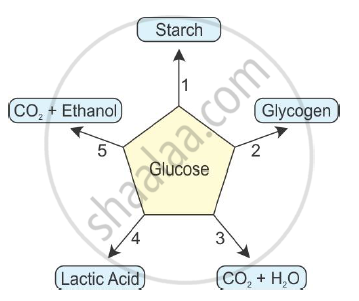Advertisements
Advertisements
प्रश्न
Internal respiration may be defined as:
पर्याय
Breathing in and releasing of oxygen in the tissue
The oxidation of food substances to release energy
The building up (synthesis) of complex substances
Getting rid of carbon dixode that would accumulate in the tissues.
उत्तर
The oxidation of food substances to release energy
Internal respiration may be defined as the oxidation of food substances to release energy.
APPEARS IN
संबंधित प्रश्न
Given below are the end products of different reactions involving glucose.

Write the reaction number in front of the following:
(i) Anaerobic reaction =
(ii) Reaction in the human muscles =
(iii) Aerobic respiration =
(iv) Reaction in the plant cells =
(v) Reaction in the liver
Which of the following is the correct statement regarding bile?
Fill in the following blank with suitable word:
The actual exchange of gases takes place in the ___________ of the lungs.
Describe the process of respiration in the following part of a plant:
Root
From where do the aquatic animals and terrestrial animals obtain oxygen for breathing and respiration?
Why is diffusion insufficient to meet the oxygen requirements of large multicellular organisms like humans?
A, B and C are three living organisms. The organism A is a unicellullar fungus which can live without air. It is used in the commercial production of an organic compound P from molasses. The organism B is a unicellular animal which lives in water and feeds and moves by using pseudopodia. It breathes through an organelle Q. The organism C is a tiny animal which acts as a carrier of malarial parasite. It breathes and respires through a kind of tiny holes R and air-tubes S in its body.
(a) What are organisms (i) A (ii) B, and (iii) C?
(b) Name (i) P (ii) Q (iii) R, and (iv) S.
(c) Which organism/organisms undergo aerobic respiration?
(d) Which organism/organisms undergo anaerobic respiration?
Consider the following chemical reactions which take place in different organisms/tissues under various conditions:
(i) Glucose → Respiration ">Ethanol + Carbon dioxide + Energy
(ii) Glucose→ Respiration ">Carbon dioxide + Water + Energy
(iii) Glucose → Respiration "> Lactic acid + Energy
(a) Name one organism which respires according to equation (i) above.
(b) Name one organism which respires according to equation (ii) above.
(c) When and where does respiration represented by equation (iii) above take place?
(d) Which equation/equations represent aerobic respiration?
(e) Which equation/equations represent anaerobic respiration?
(f) Which of the above reactions produces the maximum amount of energy?
Choose the odd one out in the following groups of four items each:
Trachea, Bronchus, Alveolus, Diaphragm
State one function of the following:
Pleural fluid
Differentiate between the following pairs on the basis of the aspect given in the brackets.
Tidal volume and Residual volume (Quantity of air)
Given below is an overall chemical reaction of a certain process:
C6H12O6→LacticAcid+2ATP+Heat enengy
Name one tissue in which this reaction occur.
Answer the following question.
A gas is released during photosynthesis. Name the gas and also state the way by which the gas is evolved.
Respiration refers to ____________.
Identify the CORRECT sequence of events for the transport of respiratory gases.
Glycolysis process occurs in which part of the cell?
Which of the following statement(s) is (are) true about respiration?
- During inhalation, ribs move inward and the diaphragm is raised
- In the alveoli, exchange of gases takes place i.e., oxygen from alveolar air diffuses into blood and carbon dioxide from the blood into the alveolar air
- Haemoglobin has a greater affinity for carbon dioxide than oxygen
- Alveoli increase surface area for the exchange of gases
How does aerobic respiration differ from anaerobic respiration?
Name the energy currency in the living organisms. When and where is it produced?
Visit a local doctor. Learn about the harmful effects of smoking. You can also collect material on this topic from other sources. You can seek help of your teacher or parents. Find out the percentage of people of your area who smoke. If you have a smoker in your family, confront him with the material that you have collected.
